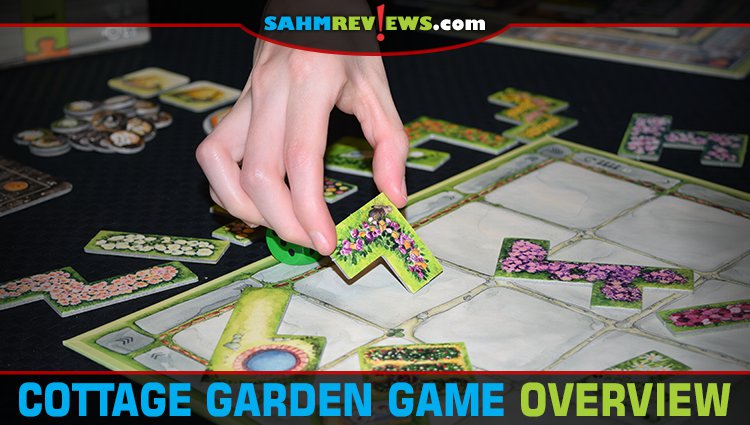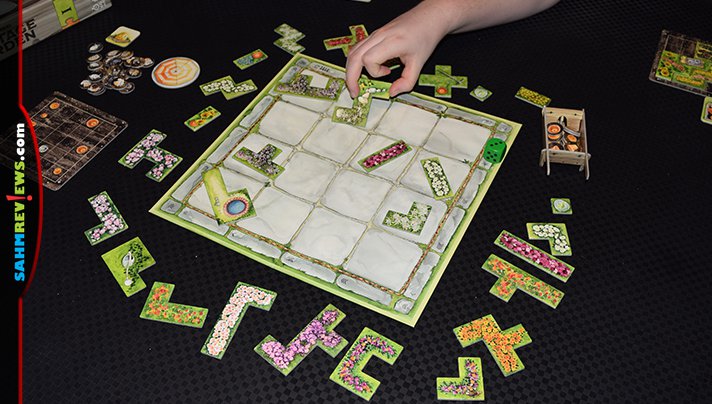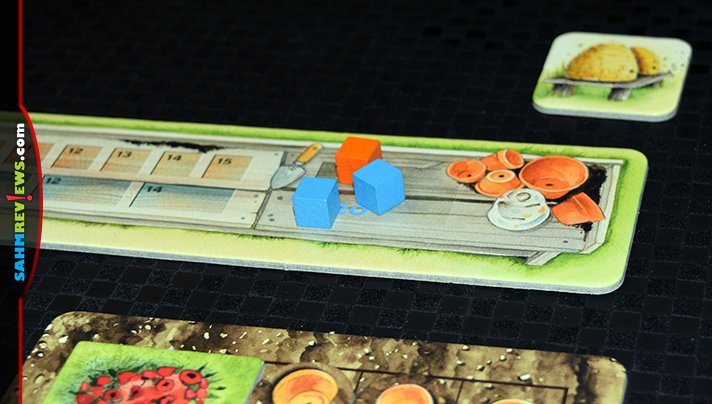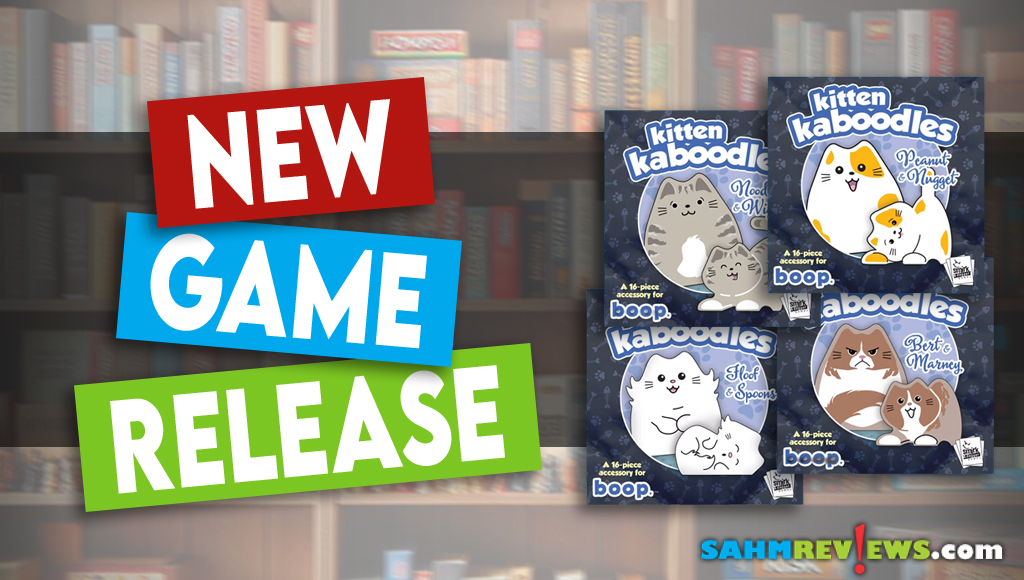Cottage Garden Game Overview

[ct_button url=”http://www.sahmreviews.com/disclosures/non-monetary-compensation” style=”btn btn-info” size=”medium” type=”square” target=”_blank”] Disclosure [/ct_button]
During a visit with my parents a couple weeks ago, we were talking about their recent trip to Alaska as well as our latest adventures with board games. During the conversation, we mentioned that games tend to revolve around various themes and a recurring theme lately is nature. We recently told you about Herbaceous: Sprouts (planting sprouts in a garden), KOI (a game about a fish pond), Wingspan and Songbirds (two very different types of games about birds) and Arboretum (one of many tree-themed games). Nature-themed games aren’t new, but the serenity they create is definitely helping them plant their roots in a very robust gaming environment.
While zombie-themed, pirate-themed or many other themed games tend to have very similar objectives within their respective groups, what I like most about this latest trend is the diversity of the styles and game play involved. As an example, Cottage Garden from Stronghold Games uses garden-themed polyomino (Tetris-like) pieces to plant into flowerbeds. As I explained a couple weeks ago during my Copenhagen game overview, I adore games with this puzzle-like component. You may recognize a little of this concept displayed in our Patchwork game overview which was designed by the same person, Uwe Rosenberg, several years ago! While it has some similarities, Cottage Garden is quite different AND plays up to four people!
Place the board in the center of the table with the side facing up that indicates the number of players. Randomly fill the board with the garden tiles then create a line of remaining tiles alongside or around the board. You’ll fill the wheelbarrow with flower pot tokens then place it at one end of the line of extra planting tiles. Each player takes one Planting table, three of each color of cube, two cat tokens and two random Flowerbeds with opposite soil types showing. The remaining Flowerbed, Cat tokens, Parasol and Beehive markers are placed near the board. The green die (the Gardener) is placed on the board with a 1 showing for 3-4 players or a 2 for 1-2 players. This die will serve as the round counter!
The game takes place over 5 or 6 rounds depending on the number of players with each round consisting multiple turns per person utilizing four phases per turn. Each turn begins with the Refilling Phase followed by the Planting Phase, Scoring Phase and Gardener Phase.
At the beginning of each turn, if there are three or four empty spaces in your row, you’ll immediately take the first tile in front of the wheelbarrow and place it in the first open space in front of the Gardener. Repeat this process until all the spaces in your row are filled. If there are two or less open spots, you may opt to spend a cat to refill the row.
So now we’re on to the meat of the game: the Planting Phase. Your goal is to completely fill your gardens using a combination of the plant tiles, flower pots, garden cloches and cats. On your turn, you must place something into one of your gardens. You may select a tile from the row designated by the Gardener or you may choose a single flower pot. Tiles may be rotated and flipped however you like and may even overlap pre-printed pots and cloches in your garden. While that’s actually taking points away from you, it may be beneficial if you’re able to acquire and place a better piece! If you’re not sure whether the piece will fit, use the parasol to mark the spot in the row while you sample the piece in your gardens.
With the exception of the final round that has alternate rules, you’ll always be working on two gardens simultaneously. When you’re selecting your flower tile pieces, you’ll want to look ahead to gauge what other pieces might be available to you and plan accordingly. At any time during your turn, you may fill in a single space with one of your cat tokens.
Each visible flower pot in your garden, whether pre-printed on the board, part of a flower tile or a single pot you choose to add is worth one point. Each visible cloche in your garden is worth two points. When your garden is full, you’ll proceed to scoring for that particular garden. If you happened to use a tile to cover some of the pre-printed pots or cloches, then you may fill your garden faster but you won’t earn the points for the ones you chose to cover!
The provided Planting Table is where you’ll keep track of your score. The three orange cubes represent the scores for Flower Pots while the three blue cubes are for the Garden Cloches. You may choose to move any of the cubes, but may not divide movement between two different ones. Each time your scoring marker passes over the line in the corner, you’ll earn another cat. Since there’s a limit on how many cats you may own, it’s important to strategically use them to have the Gardener fill the row with new pieces or to fill in single spaces in your garden. The first player to get a scoring cube into the completed section is awarded a beehive which translates to two additional end-game points. The second player to attain this goal receives one beehive for one additional point. When you’ve successfully moved all three of one color of token onto the scoring track, you’ll immediately earn a free Flower Pot which needs to be placed into your garden upon receipt.
Each time you complete and score a garden, you’ll flip that garden tile over and place it in the general supply. Then you’ll take the existing garden to start the process again. You’ll continue completing as many gardens as possible until the very last round. At that time, any garden with less than three Flower Tiles is discarded from the game. You’ll have as many turns as you need to complete your remaining garden(s). Unfortunately, you’ll lose 2 points every time you need to take another turn! When all players have finished all available gardens, the game ends and final scoring is determined.
I find Cottage Garden to be a mix of both thought-provoking game play while also being somewhat serene. It’s just one of the many games from this designer that we have in our collection and I’m looking forward to adding more. Stay tuned as we work on featuring more in this line from Stronghold Games! Curious what some of the others are? Visit their website or dig up some dirt on their Facebook and Twitter channels! If you’re ready to put your polyomino gardening skills to the test, pick up a copy of Cottage Garden on Amazon!











Animalopoly
I can not remember playing a Nature Themed Game – maybe Go Fish.
I don’t think I have ever played a nature themed game. Maybe sims and buying a farm?
Does Roadkill count?
I don’t remember ever playing a nature-themed game.
I have played Evolution, a nature themed game, and I liked it so much.
I have played Evolution, a nature themed game, and I liked it so much.
Evolution
I’ve played Evolution: The Beginning, so very nature-themed.
Photosynthesis
Does Reef count?
Wingspan
Just finished playing this game with my brother and nephew!!
Maybe Fossil would be considered a nature themed game. I played that recently
Hmmmm….I don’t remember the last time I played a nature-themed game, to be honest.
I’m going with a technicality and saying the last nature game I played was Root.
I have never played a game like this. It’s so neat. Educational & fun. Thanks for the chance.
This looks like a amazing game!!! I would love to play this with my family! The last nature game I played would have to be the Oregon trail! That game and me have had many many times together. Probably my all them favorite game and shows how people lived and truly makes you inspired of others. 🙂
Cottage Garden, nice pick!
Petrichor
Koi
Evolution has animals in it.
Indian Summer
Second best thing to having a Real cottage garden! On my bucket list… Thank you for your giveaway 🙂
I would say Go Fish.
I haven’t played a nature-themed game before.